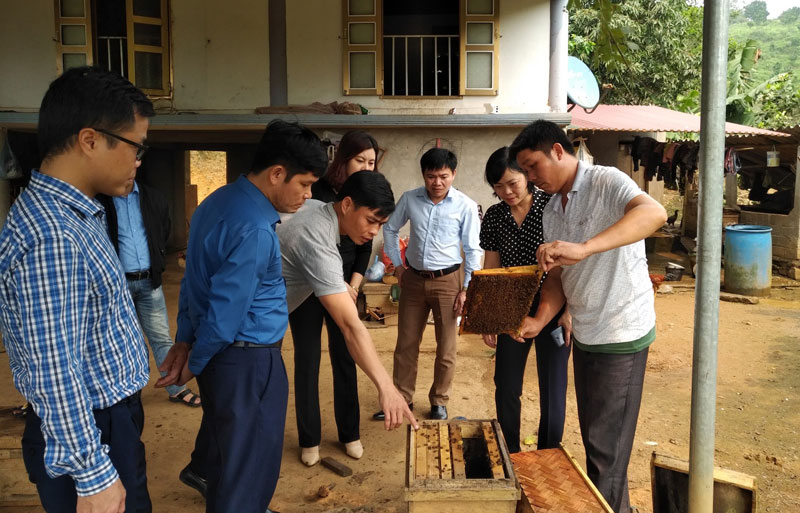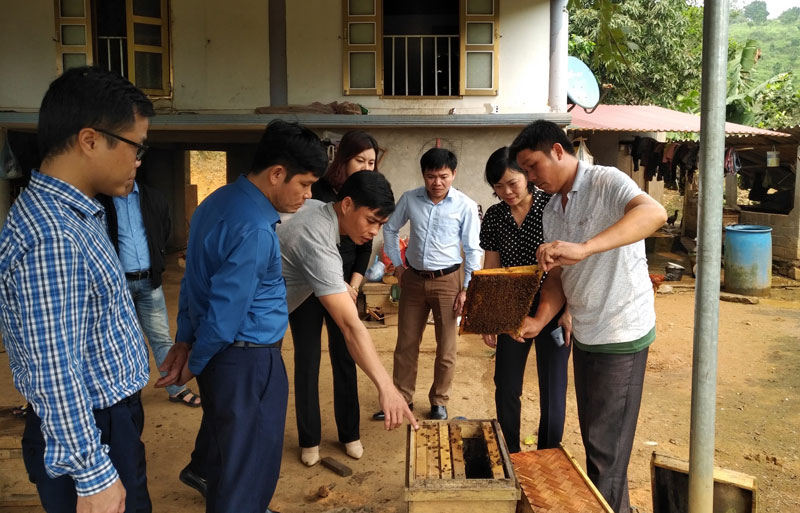
(HBO) – Phase II of the Forest and Farm Facility (FFF) programme has been carried out by Hoa Binh province Farmers’ Association since 2019. It aims to raise capacity of forest growers, families, women, youths and people of ethnic minority groups, facilitating poverty reduction and climate change adaptation.
 Officers of the
provincial Farmers’ Association survey, assess a beekeeping model in Phase II of
the FFF programme in Tu Ne commune (Tan Lac district).
Officers of the
provincial Farmers’ Association survey, assess a beekeeping model in Phase II of
the FFF programme in Tu Ne commune (Tan Lac district).
The association surveyed and decided to implement the
programme in An Binh commune (Lac Thuy district) and the communes of Dong Lai
and Tu Ne (Tan Lac district). Its project management board joined hands with local
authorities and Farmers’ Associations of districts and communes to set up key
groups at the communal level.
Training courses were arranged for members of the groups to
improve their skills and promote understanding of teamwork’s benefits, in a bid
to develop forests and farms along with keeping with environmental protection.
They were hoped to help women, youths and people of ethnic
minority groups in sustainable production of agro-forestry-fishery goods,
raising values of forests and improving landscapes and income.
The Muong Cu forest growing and beekeeping group in Cu
village of Tu Ne commune is said to be among the most effective models operated
by farmers. At present, 20 farmer households join the group, keeping a total of
600 colonies of honey bee.
Through the FFF programme, members were able to take part in
training courses in beekeeping, business skills and policy dissemination, among
others.
After one year of implementation, Phase II of the FFF programme
has seen initial results, creating a driving force for the community and
farmers to continue activities in the forest-based sector.
Three cooperatives have been set up and run effectively,
generating jobs for local workers.
The programme also facilitated the establishment of two
groups on beekeeping and growing citrus trees in Tu Ne commune, a group on
organic pomelo cultivation in Dong Lai commune (Tan Lac ditrict) and a model of
raising chickens in An Binh commune (Lac Thuy).
Products of the groups and cooperatives are shipped to various
markets with stable prices. Tens of local workhands earn stable jobs with an
average monthly income of 5 million VND (215 USD)./.
Since the beginning of this year, under the direction of the Department of Agriculture and Environment, the Sub-Department of Agricultural, Forestry, and Fishery Product Quality Management has strengthened the integration of the professional activities to promote and guide the organizations and individuals in the production and trading of agricultural, forestry, and fishery products to comply with the legal regulations regarding the use of chemicals, pesticides and veterinary medicines in crop cultivation, livestock farming and aquaculture. They also provide guidance to processing and manufacturing establishments on keeping the records to trace the product origins and using food additives from the approved list according to the regulations.
Hoa Binh province saw a significant rise in state budget revenue in the first two months of 2025, heard a meeting chaired by Vice Chairman of the provincial People’s Committee Quach Tat Liem.
Ha Thi Ha Chi, a 26-year-old graduate in law, has taken an unconventional path by returning to her hometown in Mai Chau district to establish the Tong Dau Cooperative, creating stable jobs for local women and bringing Thai ethnic brocade weaving to the global market.
As the Lunar New Year 2025 approached, pork prices surged, creating a profitable season for farmers in Tan Vinh commune, Luong Son district. Taking advantage of the rising demand, Can Minh Son, a farmer from Coi hamlet, sold over 30 pigs at 69,000 VND/kg, each weighing more than 100 kg. After deducting expenses, his family earned a profit of over 50 million VND.
alternate member of the Central Party Committee, Secretary of the Hoa Binh provincial Party Committee Nguyen Phi Long on March 5 had a working session with Yan Jiehe, Founder and Chairman of the China Pacific Construction Group, one of China's largest private corporations in the field of transport infrastructure. Deputy Secretary of the provincial Party Committee, Chairman of the provincial People's Committee Bui Duc Hinh and leaders of provincial departments and sectors also attended the working session.
The electronic printed circuit board (PCB) manufacturing and processing plant of Japan’s Meiko Group, located at Da River Left Bank Industrial Park in Hoa Binh city with a total investment of over 200 million USD, is expected to create thousands of jobs and make a significant contribution to the local budget.



 Officers of the
provincial Farmers’ Association survey, assess a beekeeping model in Phase II of
the FFF programme in Tu Ne commune (Tan Lac district).
Officers of the
provincial Farmers’ Association survey, assess a beekeeping model in Phase II of
the FFF programme in Tu Ne commune (Tan Lac district).